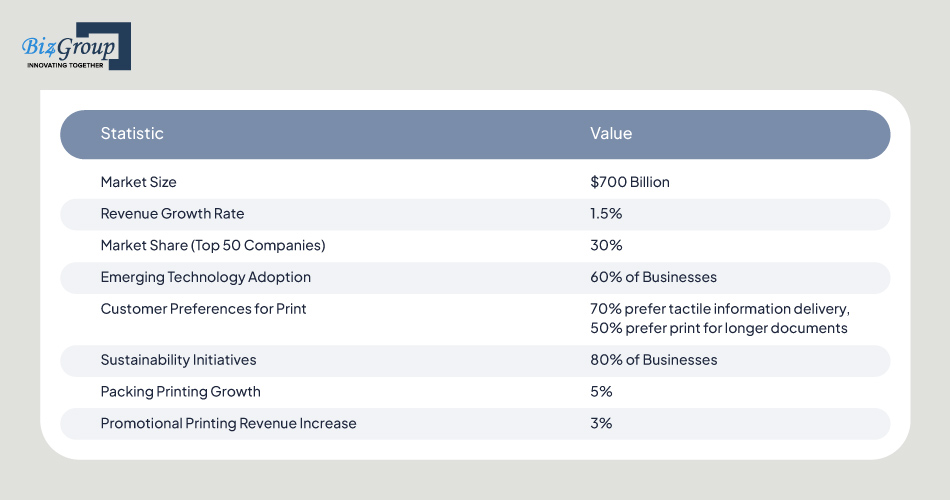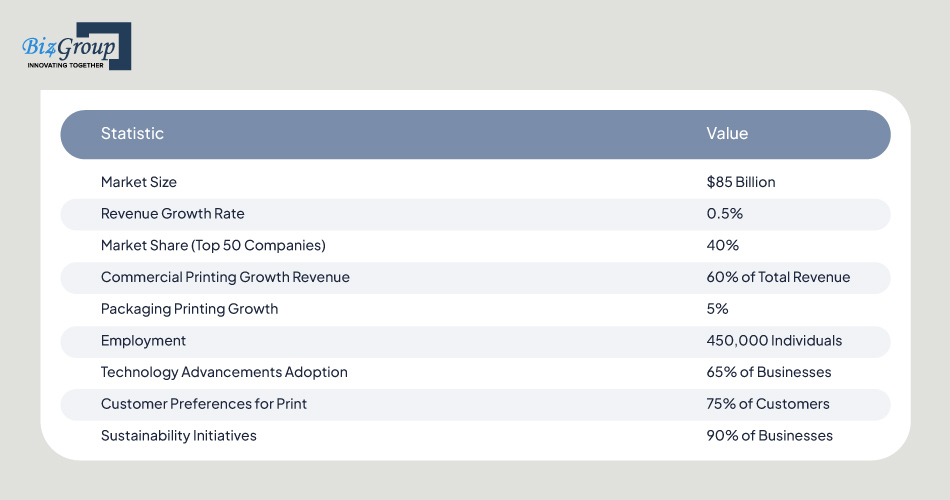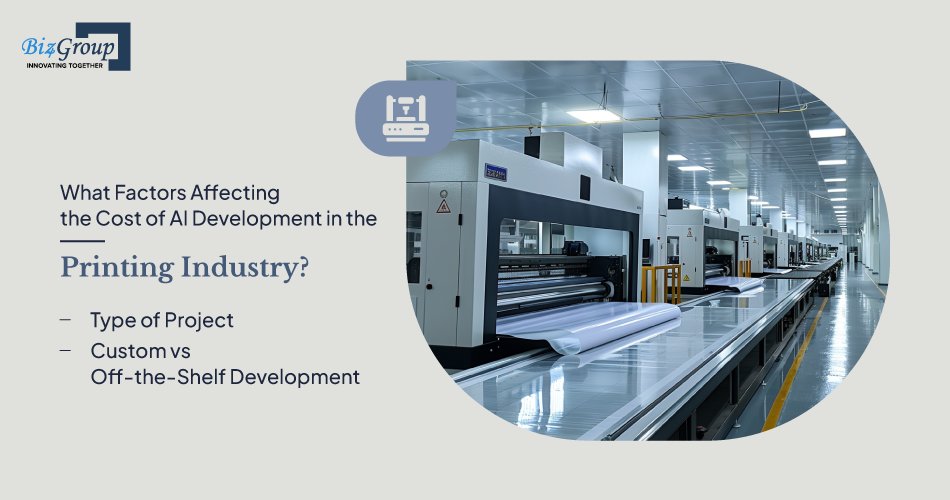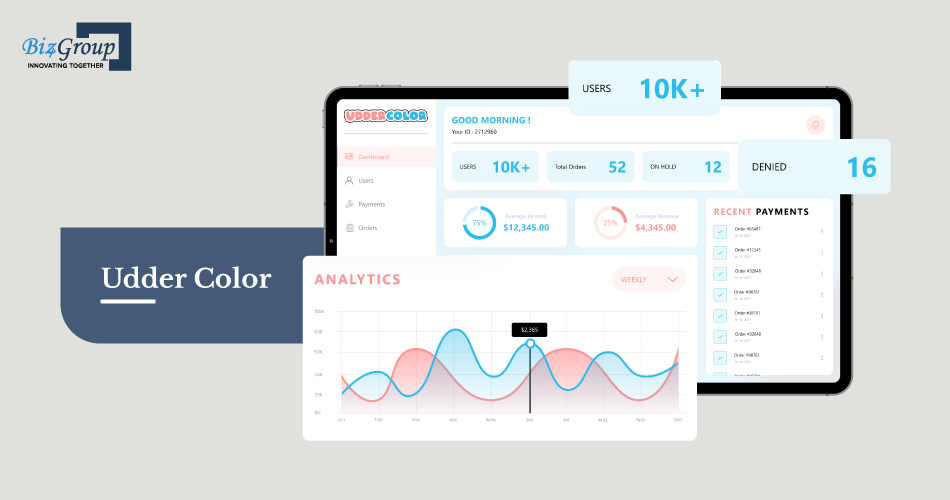Basic AI Chatbot Pricing: A simple chatbot that can answer questions about a product or service might cost around $10,000 to develop.
Read More
TL; DR

Dive into the 2024 trends and market opportunities in the global printing industry.

Understand the nuances influencing the cost of AI development in the printing sector.

Explore a successful AI integration case study with a leading US-based printing house.

Learn how AI increases the Return on Investment (ROI) in the printing business.

Discover three key steps to seamlessly implement AI while managing expenses effectively.
Artificial Intelligence (AI) has emerged as a game-changer, redefining industry standards and practices. As businesses increasingly recognize the transformative power of AI, understanding the costs involved becomes paramount. This blog explores the intricacies of implementation and the cost considerations. From analyzing the role of AI in printing to unraveling the financial aspects, we begin the journey to discover the key factors shaping the cost of AI integration in printing businesses. Let's begin.

The commercial printing industry, valued at an impressive $700 billion globally in 2023, demonstrates remarkable resilience and sustained demand amidst the digital transformation sweeping across various sectors (PwC). Despite global economic challenges, the sector exhibits a positive year-over-year revenue growth rate of 1.5%, signaling robust performance (Deloitte). Notably, the market remains fragmented, with the top 50 companies holding approximately 30% of the market share, offering ample opportunities for new entrants and smaller businesses (PwC). Embracing technological advancements, over 60% of commercial printers have invested in digital printing, 3D printing, and automation tools to streamline processes and boost productivity.
Customer preferences underscore the enduring significance of print, with around 70% valuing its tactile and personal nature for information delivery, while 50% prefer print for reading longer documents. In tandem with evolving consumer needs, the industry has witnessed a noteworthy shift towards sustainability, with 80% of businesses adopting eco-friendly practices to reduce waste and enhance efficiency.
Furthermore, specific segments within the commercial printing domain, such as packaging and promotional printing, showcase substantial growth rates of 5% and 3%, respectively, in response to e-commerce trends, sustainable packaging demands, and the continued recognition of print advertising's value (Deloitte). This multifaceted landscape reflects the industry's adaptability, innovation, and enduring appeal in a rapidly evolving business environment.

The U.S. printing industry stands as a formidable economic force, boasting a substantial market size of $85 billion, showcasing its extensive influence within the country. Despite encountering various challenges, the industry has exhibited resilience, maintaining a consistent growth rate of 0.5% over the past year, underscoring its adaptability in the face of evolving dynamics. The market's diversity is evident, with the top 50 U.S. printing companies holding approximately 40% of the industry's market share, fostering an environment where smaller businesses can actively compete.

Commercial printing services remain a pivotal contributor, constituting nearly 60% of the total revenue and emphasizing the sustained demand for such services in the United States. In tandem with global trends, the packaging printing sector in the U.S. is set to grow by 5% in 2023, driven by the surge in e-commerce and the escalating need for sustainable packaging solutions. The industry significantly contributes to employment, with approximately 450,000 individuals engaged in the U.S. printing sector, highlighting its substantial role in job creation.
Embracing technological progress, over 65% of businesses in the industry have adopted advanced printing technologies like digital and 3D printing, reflecting a commitment to innovation. Customer preferences continue to prioritize the tactile and personal nature of print, with 75% of customers in the U.S. expressing a preference for printed materials, especially for longer documents. Furthermore, an impressive 90% of U.S. printing businesses have implemented sustainability measures, focusing on reducing waste and enhancing operational efficiency, showcasing a strong commitment to environmentally conscious practices.

The cost of integrating artificial intelligence (AI) into your printing business hinges on various factors, reflecting the diverse nature of AI development. Understanding these variables is pivotal before seeking cost estimates. AI encompasses different types, ranging from widely used and easily developed solutions to cutting-edge, complex ones. This diversity significantly influences project costs.
1. Type of Project: Choosing between custom AI solutions, developed from scratch to meet specific needs, and off-the-shelf solutions with pre-built algorithms affects costs. Custom solutions, tailored to business requirements, demand extensive time and effort, with costs ranging from $5000 to over $150k. In contrast, off-the-shelf solutions, like pre-built chatbots, offer a quicker, more affordable option, costing between $99 to $500 per month.
2. Custom vs Off-the-Shelf Development: When considering the integration of artificial intelligence (AI) in the printing industry, businesses face a crucial decision: opt for custom AI development or leverage off-the-shelf solutions. Custom AI development offers tailored solutions aligned with specific printing needs but comes with higher initial costs and longer development timelines. Conversely, off-the-shelf AI solutions provide quicker deployment and cost savings but may lack the precision required for intricate printing processes.
Navigating the choice between custom AI development and off-the-shelf solutions involves a comprehensive analysis of the printing business's unique requirements, budget considerations, and long-term scalability goals. Each option presents its advantages and challenges, underscoring the need for a strategic decision that aligns with the dynamic landscape of AI in the printing industry.
2. Type of AI Software: AI comprises technology-based, functionality-based, and capability-based categories. Each type, from robotic process automation to limited-memory AI, involves distinct development processes and resources, influencing overall costs. The categorization is as follows:
Technology-Based AI:
Technology-based AI solutions leverage various cutting-edge technologies, including robotic process automation, speech recognition, computer vision, and data science. Applicable across diverse industries, from call centers to healthcare, these solutions exemplify the versatility of AI applications.
Functionality-Based AI:
Categorized by their operational roles, functionality-based AI encompasses reactive machines, limited memory systems, theory of mind, and self-awareness. Reactive machines respond without experience, while limited memory AI, like chatbots, leverages past data for optimal decision-making. The evolution towards a theory of mind and self-awareness AI represents a nascent stage, approaching a level of consciousness akin to human cognition.
Capability-Based AI:
Once functional, AI software gains identity through capabilities. Artificial Narrow Intelligence (ANI) involves specialized tasks like Siri or facial recognition. Artificial General Intelligence (AGI) encompasses broader applications, while Artificial Super Intelligence (ASI) envisions highly self-aware machines still in development.
These diverse categories showcase the expansive role and potential of AI across various technological and functional dimensions.
3. AI Task Requirements: When considering the integration of AI into a business, meticulous attention to specific factors is crucial for determining the task requirements and, subsequently, the cost of AI development. Tailoring AI software to meet business needs requires a nuanced understanding of various elements. The desired level of intelligence, the nature and volume of data to be processed, and the targeted accuracy of the algorithm are pivotal considerations. The complexity of the AI project, ranging from straightforward chatbots to intricate software, influences infrastructure requirements such as cloud-based backends, APIs, dashboards, voice assistants, and streaming tools. Additionally, anticipating future scalability adds a layer of complexity, impacting development costs.
4. AI Features: Specific features, such as natural language processing, deep learning, or image recognition, tailored to task requirements, impact the final cost. For instance, tasks involving text generation using generative AI development or question answering necessitate natural language processing, while machine learning aligns with deep learning. The precision and efficiency of AI hinge on incorporating industry-trusted features, impacting the overall cost. As businesses navigate the landscape of AI in printing, understanding the role and cost implications of these features becomes crucial.
5. Hardware Costs: Hardware, essential for running AI algorithms, introduces additional expenses. Options include on-premises hardware (GPUs, ASICs, TPUs) and cloud-based alternatives. Choosing between these options depends on the business's needs, with hardware costs not typically included in development quotes.
AI hardware, GPUs, FPGAs, and ASICs cater to diverse needs. GPUs, exemplified by the Nvidia A100, are crucial for neural network training, while FPGAs, though less expensive than GPUs, pose programming challenges. ASICs, custom-built for specific tasks, offer high performance at a variable, often high cost.
Considerations include rental costs on cloud platforms, with GPUs on Google Cloud at ~$1.14/hr and ~$3.06/hr on AWS. FPGAs range from $5 to over $100,000, and ASIC costs depend on customization and performance requirements. This hardware overview aids businesses in strategic decision-making for efficient AI integration.

6. Manpower: the cost is not solely dictated by technology; the labor-intensive process of implementation plays a pivotal role. Even within a small business, the AI development team's expense can surpass $300,000 annually.
This team encompasses diverse roles crucial for successful AI integration, including a data scientist, machine learning engineer, AI developer, software developer, and project manager. The cost of each team member varies based on skill set and experience, directly impacting the overall budget. A nuanced understanding of the composition of the AI development team is essential for businesses seeking efficient and cost-effective integration, emphasizing the significance of comprehensive cost analysis in navigating the transformative landscape of AI in printing.
7. Management and Maintenance: Choosing between in-house or outsourced management teams significantly impacts the cost dynamics of implementing artificial intelligence (AI) in the printing industry. In-house teams may incur higher expenses due to salaries and infrastructure, adding a substantial upfront financial load. On the contrary, outsourced teams eliminate salary overheads but may introduce service costs. Regular maintenance, crucial for sustaining AI's optimal performance, adds to the ongoing expenses.
The annual cost of maintaining an AI product in the printing industry averages around $60,000. While this may initially appear substantial, the productivity and efficiency gains achieved through AI are remarkable, justifying the investment. The nuanced decision between in-house and outsourced management teams requires a thorough cost analysis, considering long-term benefits.
8. Project Duration: The temporal dimension of AI implementation in the printing industry intricately intertwines with overall costs. The time invested in crafting AI solutions is a pivotal determinant, considering various factors like complexity and project scope.
Basic AI versions developed swiftly incur lower costs, while more intricate Minimum Viable Product (MVP) versions demand extended efforts, inevitably influencing expenses. Hourly rates, a key metric in cost assessment, are derived from a comprehensive evaluation encompassing the total developers involved and hours dedicated to project completion.
The AI development company must strike a balance, ensuring the per-hour cost aligns with the client's budget expectations. Negotiations may ensue if the projected cost surpasses the predetermined financial parameters, emphasizing the crucial role time plays in the cost dynamics of AI implementation in the printing domain.
Therefore, comprehending these factors is integral to navigating the landscape of AI integration costs in the printing industry. The nuanced decisions around project specifics significantly shape the financial investment necessary for harnessing AI's transformative power in printing.

We partnered with a leading US-based printing house to transform their outdated business website into a cutting-edge platform for custom artwork printing. The challenge was to create a secure, efficient, and scalable system capable of handling numerous order requests simultaneously, and yes, we did it successfully.

It resulted in the developed web app meeting and exceeding expectations, providing users with a seamless experience for ordering custom printable heat transfers. With a robust approval process, secure payment options, and various membership benefits, the platform stands as a testament to the successful implementation of AI in the printing industry. This case study highlights the transformative role of AI in enhancing efficiency, user experience, and overall business operations in the printing sector.
Artificial Intelligence (AI) emerges as a game-changer, significantly enhancing Return on Investment (ROI). Implementing AI in printing optimizes operational efficiency, reduces errors, and enhances print quality.
The cost of AI implementation is outweighed by long-term gains. Through AI-driven automation, tasks like color correction, image scaling, and layout optimization become streamlined, reducing manual efforts and increasing accuracy.
Predictive maintenance, another facet of AI, minimizes downtime and prolongs machinery lifespan, contributing directly to ROI. The role of AI in 3D printing further accentuates these benefits, offering precision and waste reduction. The printing industry's strategic adoption of AI underscores its pivotal role in achieving sustainable growth, making the initial investment a wise choice for long-lasting profitability.
For your better understanding, let's look at the infographic.
Market Size:

Embracing AI in the printing business can be transformative, but navigating the implementation process is crucial. Achieving cost-effective integration requires strategic planning. Let's explore three key steps to seamlessly implement AI, ensuring optimal results while managing expenses effectively.
Define precise goals for AI integration. Identify areas where AI can enhance accuracy, reduce waste, or streamline processes. Clear objectives guide decision-making throughout implementation, preventing scope creep and cost overruns.
Select AI solutions tailored to your printing needs. Assess the scope and complexity of tasks. Whether it's image recognition, predictive maintenance, or smart layouts, align AI technologies with specific objectives to maximize efficiency and minimize unnecessary expenses.
Engage with seasoned AI experts who understand the intricacies of the printing industry. Experienced partners contribute valuable insights, accelerate development, and ensure a smooth integration process, optimizing costs and enhancing the overall success of AI implementation in printing.
In conclusion, navigating the cost of AI implementation in printing is pivotal for businesses. The analysis of the cost of AI in printing unveils its transformative role, redefining accuracy, efficiency, and waste reduction. As the printing industry integrates AI and printing, understanding the role of AI becomes indispensable for sustainable growth. Despite initial investments, the long-term benefits position AI as a cornerstone for precision and innovation. Embracing artificial intelligence in printing is not merely an option but a strategic involvement. Explore the transformative journey of AI in printing today for a visionary tomorrow.

As of 2023, the global market size for the printing industry is an impressive $700 billion, showcasing resilience and sustained demand despite digital transformations in various sectors (PwC).
AI features like natural language processing can impact costs based on their complexity and integration requirements. While off-the-shelf solutions might offer cost-effective options for simpler tasks, complex and customized natural language processing applications can contribute to higher development costs.
The average annual cost of maintaining an AI product in the printing industry is around $60,000. Regular maintenance is crucial for sustaining optimal performance and justifies the investment through remarkable productivity and efficiency gains.
Yes, AI-driven automation has the potential to significantly reduce labor costs in the printing business. By automating tasks such as color correction, image scaling, and layout optimization, manual efforts are minimized, leading to substantial cost savings and increased operational efficiency.
Monthly revenue estimations for AI in printing vary across countries. Rough estimates include:
- United States: $20,000 - $100,000+
- Germany: €15,000 - €80,000+
- China: ¥50,000 - ¥300,000+
- United Kingdom: £10,000 - £60,000+
- India: ₹100,000 - ₹500,000+
- Brazil: R$10,000 - R$50,000+
- Australia: AUD 15,000 - AUD 80,000+
- Japan: ¥500,000 - ¥2,500,000+.
Note: These are rough estimates, and actual success depends on business strategy, marketing efforts, and service uniqueness.
with Biz4Group today!
Our website require some cookies to function properly. Read our privacy policy to know more.